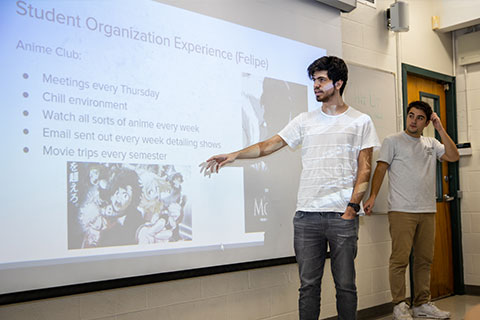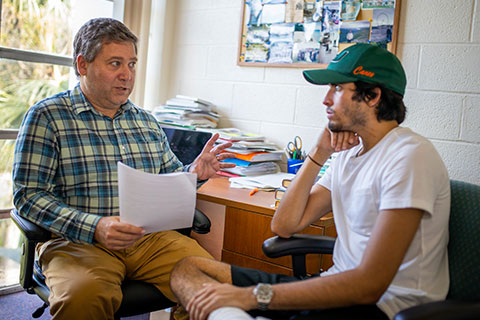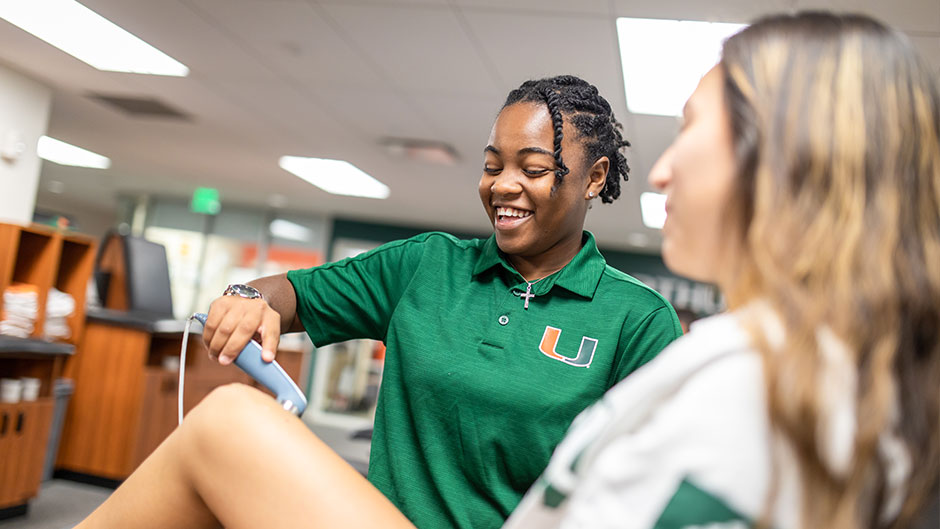When Dynesha Peterson moved into her residence hall freshman year, she was thrilled to be a Hurricane, but things soured quickly. She did not connect well with anyone on her floor, and her transition to college did not go as smoothly as she’d hoped.
Peterson quickly began to rethink her decision to move to Miami, far away from her four younger siblings in Orlando.
“I was wondering if I made the wrong decision,” said Peterson, who is the first in her family to attend college.
Yet two years later, Peterson is thriving in the athletic training program, and working as a supervisor at the Patti and Allan Herbert Wellness Center. She has lots of friends, and volunteers with Inspire U, which helps guide underrepresented high school students toward a college education.
“Spring semester of freshman year, I found my niche and the circles of people I wanted to be with,” said Peterson.
Although few students actually leave the University of Miami after their first year, members of a student retention task force are working hard to ensure that students like Peterson never consider it. Today, 93 percent of the University’s freshman class returns after their first year, but that’s not good enough, administrators say. They want students to feel immediately at home and are piloting a number of initiatives to reduce the 7 percent of new students who leave.
“Our goal is to ensure that every student is socially, intellectually, and academically supported from their first to last day at the University of Miami, so that they graduate successfully,” said Jeffrey Duerk, provost and executive vice president for academic affairs, who convened the task force.
Headed by Darby Plummer, director of student retention, and Maria Stampino, a senior associate dean in the College of Arts and Sciences, the task force includes faculty, staff, students, and administrators from across the University. Among their initiatives: a first-year directions course for students in the College of Engineering and in the School of Education and Human Development; initiatives to provide extra support in some introductory math and writing classes; and a program for first-generation college students called SOAR, or Students Optimizing and Accessing Resources.

Plummer is uniquely positioned to understand why some students leave the University. As part of her job, she leads the ’Cane Success Center, which conducts exit interviews with departing students. Plummer said the reasons students leave are typically complex.
“A lot of times we’ll unravel a student challenge, like a student is struggling with a class, and then that affects their financial aid, so one problem can snowball,” Plummer said. “We work with the other offices on campus to tease out the problem into manageable buckets.”
Other students simply haven’t found their comfort zone.
“One of the issues we hear from students who are leaving is they are not able to fit into the University,” said Dave Becher, associate provost for data governance and institutional research and the founding director of the task force.
Peterson said she understands that sense of alienation. She was mentally preparing to leave freshman year, when things started to improve. She met some friends at the Butler Center for Service and Leadership, and got a job at the Wellness Center.
Peterson now spends mornings working with the running backs on the football team, and is on track to graduate in the spring of 2021.
Still, she credits a few key mentors with helping her learn to navigate the University her first year.
The retention task force is mining university data, which can pinpoint some other signs a student may be struggling. For example, a student may stop showing up to class or their grades may falter. Those signs were apparent to Leonidas Bachas, dean of the College of Arts and Sciences, who noticed a way to tackle the issue. Since most of the University’s first-year students must take English 105, a writing course, he asked the writing program’s faculty to send him and an academic adviser the names of every student who was struggling.
Adina Sanchez-Garcia, associate director of the writing program, said those simple e-mails helped catch students who may need additional help. Now, the task force is using the writing program as a model for how to help students across the U.

“It started off casually, but then we began to see the impact it had,” Sanchez-Garcia said. “We’ve seen many instances where if we hadn’t intervened, maybe the student would have left.”
The College of Engineering piloted a first-year directions course this fall to orient computer engineering majors to the U, and keep them in the program. Chris Hartnett, a senior facilitator and learning specialist who served as the instructor, took his students on tours of campus facilities and created engaging assignments, like a campus quest, to help new ’Canes engage with peers and available resources.
Senior Nathan Furman, an electrical engineering major and teaching assistant for the course, said the class helps build community among students on the same academic path, which is useful for a challenging major like computer engineering.
“Through this class, freshmen can connect with their peers and people they will share similar experiences with,” said Furman, who is also a first-year fellow, or a student academic adviser who lives in the residential colleges. “Having a space to facilitate that interaction is really important.”
At the conclusion of the course, students will participate in a focus group, so the retention task force can evaluate the classes. Members are also developing other programs to support students at other stages of their University journey, Plummer said.
Freshman engineering major Esther Alexandre said the directions course helped her find a tutoring center in the College of Engineering, which has boosted her confidence in a programming course.
“This class gives you the opportunity to learn where things are on campus and has taught me a lot,” she said. “Also, my grade has improved since I started visiting the fourth floor of the McArthur Engineering building [for tutoring].”
Now, Peterson feels so connected to the U that she knows many mentors or friends she could call at any time to help her. “I don’t know if I could do that at another university,” she said.

